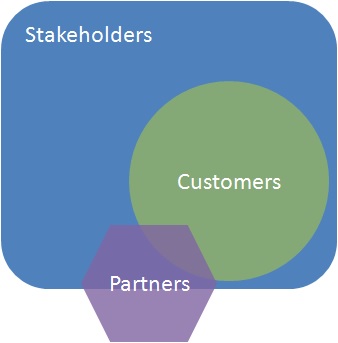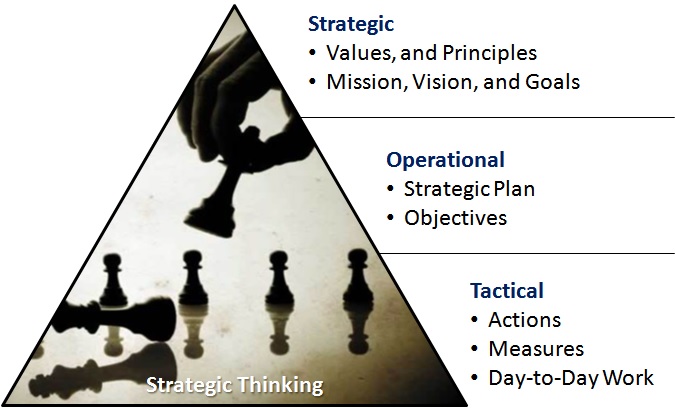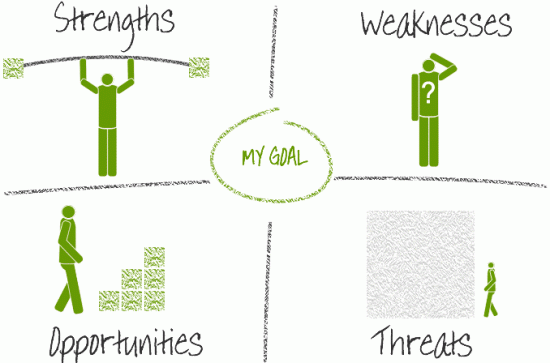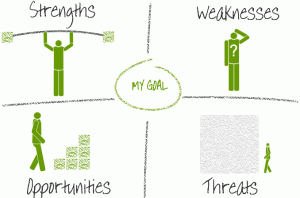 Strategic planning, as a structured and systematic process, is successful when it is leader-led and overcomes the five reasons 70% of all strategies fail. Learn how to see your plan through to success. The strategic planning process is where leaders of an organization establish the vision of the organization’s future and then develop and implement the actions necessary to achieve that future. This article expands on the strategic planning concepts addressed in Think Big, Take Small Steps and is designed to help you achieve success in your strategic planning process.
Strategic planning, as a structured and systematic process, is successful when it is leader-led and overcomes the five reasons 70% of all strategies fail. Learn how to see your plan through to success. The strategic planning process is where leaders of an organization establish the vision of the organization’s future and then develop and implement the actions necessary to achieve that future. This article expands on the strategic planning concepts addressed in Think Big, Take Small Steps and is designed to help you achieve success in your strategic planning process.
Developing a Well-informed Strategic Framework is the Second Crucial Step in Strategic Planning.
All successful plans start with an Executable Focus. If a plan lacks focus on fixing organizational problems and overcoming barriers to the organization’s vision it is not built on the realities of the environment impacting the organization. When plans are built in a vacuum with by leaders or a planning team sitting in a conference room one afternoon, they often lack this focus. This was the focus of the last several blog articles designed to guide you through How to Conduct an Organizational Assessment. The last ten weeks were designed to outline the first step in ensuring strategic planning doesn’t fail–building an executable focus.
The second step of Think Big, Take Small Steps, is to develop a well-informed Strategic Framework with a purposeful and everlasting mission statement; an inspiring and far-reaching vision statement; and three to five broad goals that encompass what must change.
The leadership’s primary role is to decide the direction of the organization and when the plan is not developed by the input of organizational leadership, it does not have their buy-in. Just as importantly, a plan built without the input of the organization’s personnel will have an equally difficult time of gaining approval and traction.
Over the next six weeks we will focus on conducting an effective strategic planning offsite and ensuring we develop a strong mission and vision statement and effective goals. We will also discuss establishing core values and principles that don’t exist and how to adjust those that exist, but are not the ones the company desires to drive the right behavior.
The focus of these articles, like the ones before, are really for someone to facilitate the strategic planning activity, but any organization could pick these steps up and complete them end to end.
So, 70% of all plans fail to some level; however, by following these guidelines you can help ensure your strategic plan will be one of the 30% successes that everyone reads about.






 Strategic planning, as a structured and systematic process, is successful when it is leader-led and overcomes the five reasons 70% of all strategies fail. Learn how to see your plan through to success. The strategic planning process is where leaders of an organization establish the vision of the organization’s future and then develop and implement the actions necessary to achieve that future. This article expands on the strategic planning concepts addressed in
Strategic planning, as a structured and systematic process, is successful when it is leader-led and overcomes the five reasons 70% of all strategies fail. Learn how to see your plan through to success. The strategic planning process is where leaders of an organization establish the vision of the organization’s future and then develop and implement the actions necessary to achieve that future. This article expands on the strategic planning concepts addressed in 
 Leadership is a dying art in the world today. The great leaders of the past are found few-and-far between these days. There are some that have been fairly successful leaders that have rose to an iconic status, but have they been truly great leaders or just really successful at running something?
Leadership is a dying art in the world today. The great leaders of the past are found few-and-far between these days. There are some that have been fairly successful leaders that have rose to an iconic status, but have they been truly great leaders or just really successful at running something?

 Strategic planning, as a structured and systematic process, is successful when it is leader-led and overcomes the five reasons 70% of all strategies fail. Learn how to see your plan through to success. The strategic planning process is where leaders of an organization establish the vision of the organization’s future and then develop and implement the actions necessary to achieve that future. This article expands on the strategic planning concepts addressed in
Strategic planning, as a structured and systematic process, is successful when it is leader-led and overcomes the five reasons 70% of all strategies fail. Learn how to see your plan through to success. The strategic planning process is where leaders of an organization establish the vision of the organization’s future and then develop and implement the actions necessary to achieve that future. This article expands on the strategic planning concepts addressed in 





 Strategic planning, as a structured and systematic process, is successful when it is leader-led and overcomes the five reasons 70% of all strategies fail. Learn how to see your plan through to success. The strategic planning process is where leaders of an organization establish the vision of the organization’s future and then develop and implement the actions necessary to achieve that future. This article expands on the strategic planning concepts addressed in
Strategic planning, as a structured and systematic process, is successful when it is leader-led and overcomes the five reasons 70% of all strategies fail. Learn how to see your plan through to success. The strategic planning process is where leaders of an organization establish the vision of the organization’s future and then develop and implement the actions necessary to achieve that future. This article expands on the strategic planning concepts addressed in 
 Strength. Strengths are internally positive aspects about the organization. These are the things that make the organization strong and are the main things an organization can leverage to overcome internal weaknesses and external threats. Organizations tend to focus only on their weaknesses and take their strengths for granted. A failure to focus on and nurture your organizational strengths can quickly turn them into a negative. When you brainstorm to build a SWOT, you tend to come up with a lot of perceived strengths, some of which might not be true.
Strength. Strengths are internally positive aspects about the organization. These are the things that make the organization strong and are the main things an organization can leverage to overcome internal weaknesses and external threats. Organizations tend to focus only on their weaknesses and take their strengths for granted. A failure to focus on and nurture your organizational strengths can quickly turn them into a negative. When you brainstorm to build a SWOT, you tend to come up with a lot of perceived strengths, some of which might not be true. Weakness. Weaknesses are also internal to the organization, but these are the challenges that could prevent the organization from achieving its eventual vision. Only the most glaring weaknesses are normally highlighted by an organization when brainstorming and usually this list is short. When done correctly, this tends to be a long and difficult list for leaders to swallow. Although it doesn’t sound like SWOT, I often refer to this box as Challenges (a SCOT). Nothing in an organization will prevent it from achieving its vision, unless they fail to address the challenges in front of them.
Weakness. Weaknesses are also internal to the organization, but these are the challenges that could prevent the organization from achieving its eventual vision. Only the most glaring weaknesses are normally highlighted by an organization when brainstorming and usually this list is short. When done correctly, this tends to be a long and difficult list for leaders to swallow. Although it doesn’t sound like SWOT, I often refer to this box as Challenges (a SCOT). Nothing in an organization will prevent it from achieving its vision, unless they fail to address the challenges in front of them. Opportunity. Many times Opportunities and Threats can be the same thing, but simply it’s the way you look at them. Basically, these both fall into a risk category. Opportunities are positive and external to the organization. If you have an opportunity that exists within your organization, then it is a Strength that you just aren’t leveraging at the moment. The importance of focusing on the external factor of it is that there is less of a guarantee that you can turn Opportunities into Strengths. Many organizations, especially those that don’t currently have a strategic plan or the one that exists is poor, fail to focus on the external factors. Extremely effective strategies focus more on the external factors then the internal. This is how you develop strategic positioning and become prepared for the what might happen versus dealing with it when it happens.
Opportunity. Many times Opportunities and Threats can be the same thing, but simply it’s the way you look at them. Basically, these both fall into a risk category. Opportunities are positive and external to the organization. If you have an opportunity that exists within your organization, then it is a Strength that you just aren’t leveraging at the moment. The importance of focusing on the external factor of it is that there is less of a guarantee that you can turn Opportunities into Strengths. Many organizations, especially those that don’t currently have a strategic plan or the one that exists is poor, fail to focus on the external factors. Extremely effective strategies focus more on the external factors then the internal. This is how you develop strategic positioning and become prepared for the what might happen versus dealing with it when it happens. Threat. Obviously, Threats are the external negative aspects surrounding an organization. These are significant threats that the organization faces or could face in the future that they have no control over. Competitors and government regulations often fall into this category. If your organization is part of a bigger organization, things like down-sizing, reorganizations, and funding, even though they exist in the greater organization, still can be external to your control. The two biggest things about Threats is to determine ways to either turn a Threat into an Opportunity, or to develop a mitigation plan should the Threat materialize.
Threat. Obviously, Threats are the external negative aspects surrounding an organization. These are significant threats that the organization faces or could face in the future that they have no control over. Competitors and government regulations often fall into this category. If your organization is part of a bigger organization, things like down-sizing, reorganizations, and funding, even though they exist in the greater organization, still can be external to your control. The two biggest things about Threats is to determine ways to either turn a Threat into an Opportunity, or to develop a mitigation plan should the Threat materialize.
